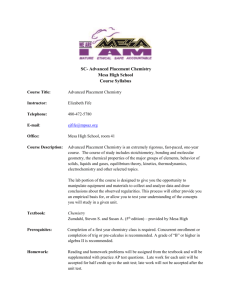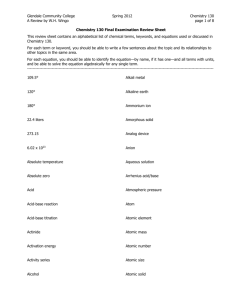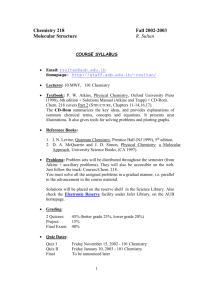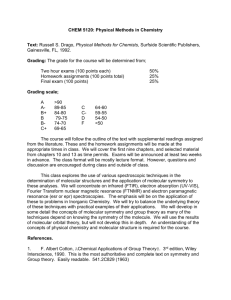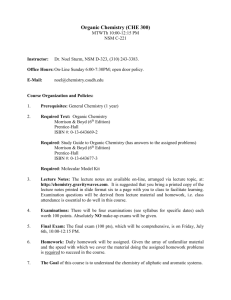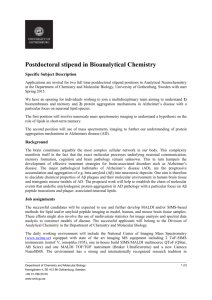chemistry 1110, general chemistry i
advertisement
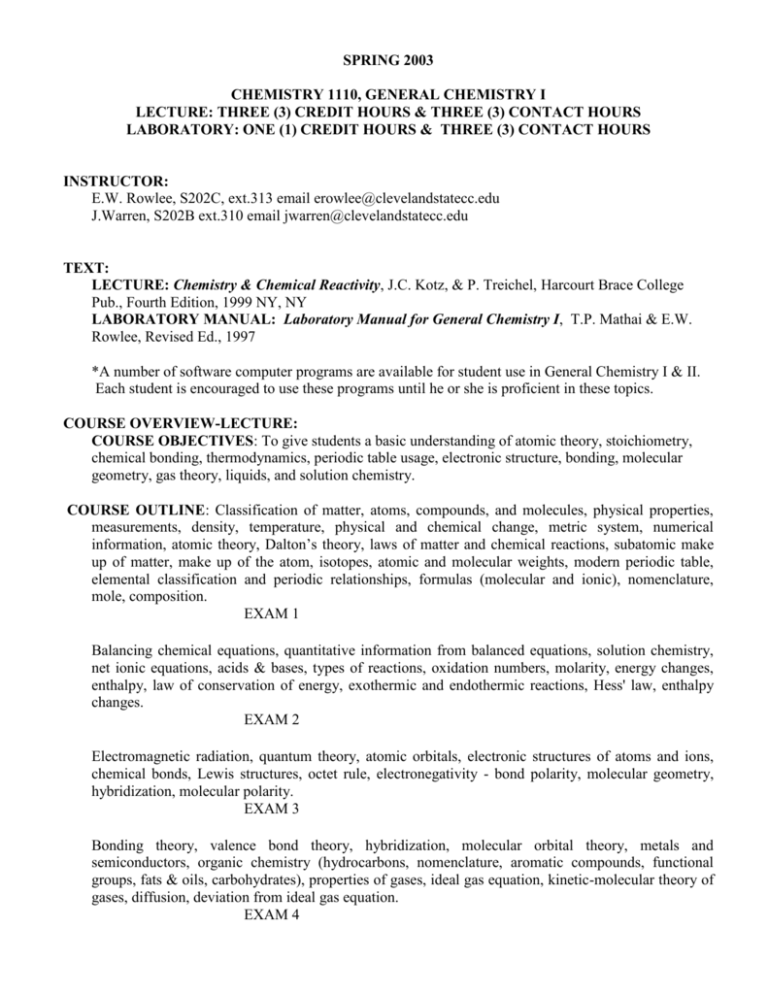
SPRING 2003 CHEMISTRY 1110, GENERAL CHEMISTRY I LECTURE: THREE (3) CREDIT HOURS & THREE (3) CONTACT HOURS LABORATORY: ONE (1) CREDIT HOURS & THREE (3) CONTACT HOURS INSTRUCTOR: E.W. Rowlee, S202C, ext.313 email erowlee@clevelandstatecc.edu J.Warren, S202B ext.310 email jwarren@clevelandstatecc.edu TEXT: LECTURE: Chemistry & Chemical Reactivity, J.C. Kotz, & P. Treichel, Harcourt Brace College Pub., Fourth Edition, 1999 NY, NY LABORATORY MANUAL: Laboratory Manual for General Chemistry I, T.P. Mathai & E.W. Rowlee, Revised Ed., 1997 *A number of software computer programs are available for student use in General Chemistry I & II. Each student is encouraged to use these programs until he or she is proficient in these topics. COURSE OVERVIEW-LECTURE: COURSE OBJECTIVES: To give students a basic understanding of atomic theory, stoichiometry, chemical bonding, thermodynamics, periodic table usage, electronic structure, bonding, molecular geometry, gas theory, liquids, and solution chemistry. COURSE OUTLINE: Classification of matter, atoms, compounds, and molecules, physical properties, measurements, density, temperature, physical and chemical change, metric system, numerical information, atomic theory, Dalton’s theory, laws of matter and chemical reactions, subatomic make up of matter, make up of the atom, isotopes, atomic and molecular weights, modern periodic table, elemental classification and periodic relationships, formulas (molecular and ionic), nomenclature, mole, composition. EXAM 1 Balancing chemical equations, quantitative information from balanced equations, solution chemistry, net ionic equations, acids & bases, types of reactions, oxidation numbers, molarity, energy changes, enthalpy, law of conservation of energy, exothermic and endothermic reactions, Hess' law, enthalpy changes. EXAM 2 Electromagnetic radiation, quantum theory, atomic orbitals, electronic structures of atoms and ions, chemical bonds, Lewis structures, octet rule, electronegativity - bond polarity, molecular geometry, hybridization, molecular polarity. EXAM 3 Bonding theory, valence bond theory, hybridization, molecular orbital theory, metals and semiconductors, organic chemistry (hydrocarbons, nomenclature, aromatic compounds, functional groups, fats & oils, carbohydrates), properties of gases, ideal gas equation, kinetic-molecular theory of gases, diffusion, deviation from ideal gas equation. EXAM 4 COURSE OVERVIEW-LABORATORY: All laboratory experiments must be completed for a grade in chemistry. Exercise Laboratory Date 1 Measurements and Techniques Jan. 9, 10 2 Calibration of Apparatus Jan. 9, 10 4 Formulas and equations Jan. 16, 17 3 Physical Properties of Substances Jan. 23, 24 5 Chemical Reactions Jan. 30, 31 6 Determination of a Chemical formula Feb. 6, 7 7 Thermochemistry Feb. 13, 14 8 Hydrogen Spectrum Feb. 20, 21 9 Atomic Structure Feb. 27, 28 10 Chemical bonding Mar. 6, 7 11 Molecular Structure Mar. 13, 14 15 Titration I (acid-base) Mar. 20, 21 16 Titration II (acid-base) Apr. 3, 4 28 Molecular Geometry Apr. 10. 11 29 Functional Groups Apr. 17, 18 12 Charles' Law Apr. 24, 25 13 Molecular Weight of a Volatile Liquid Apr. 24, 25 14 Gas Law Constant, "R" May 1, 2 PROBLEM ASSIGNMENTS: Problem assignments for each chapter in the text listed below. Several of these problems from each chapter will be taken up for a grade, problems sets covering each chapter are on available on departmental computer and on reserve in the Library. Chapter problems 1 3, 7, 13, 23, 33, 41, 45, 53 2 3, 9, 15, 23, 27, 37, 51 3 5, 7, 13, 21, 25, 29, 39, 43, 47, 49, 65, 73 4 3, 11, 17, 23, 30, 37, 43, 47 5 1, 5, 9, 12, 17, 19, 29, 37, 41, 53, 57, 61, 67, 71, 73, 79, 85 6 5, 11, 25, 33, 36, 40, 51, 63, 75 7 3, 7, 11, 12, 21, 25, 29, 35, 42, 48 8 5, 6, 13, 32, 44, 49, 53, 5871 9 1, 4, 10, 11, 16, 30, 32, 39, 47, 57, 77, 91 10 1, 3, 14, 17, 21, 29, 31, 42, 53 11 7, 13, 19, 23, 33, 44 12 2, 4, 5, 19, 21, 27, 45, 61, 67, 77, 89 LEARNING OUTCOMES: TBR Mandated Generic Liberal Arts Outcomes: 1. Conduct an experiment, collect and analyze data, and interpret results in a laboratory setting. 2. Analyze, evaluate and test a scientific hypothesis. 3. Use basic scientific language and processes, and be able to distinguish between scientific and nonscientific explanations. 4. Identify unifying principles and repeatable patterns in nature, the values of natural diversity, and apply them to problems or issues of a scientific nature. 5. Analyze and discuss the impact of scientific discovery on human thought and behavior. Academic outcomes: A student should be able to: 1. demonstrate basic understanding of atomic theory 2. balance chemical equations and perform stoichiometry calculations 3. give the basic ideas of chemical bonding 4. perform thermodynamics calculations of enthalpy and Hess's law 5. give the relationships of atoms of elements on the periodic table 6. give electronic structure of atoms and ions 7. describe the basic types of molecular geometry and identify molecules of each type 8. name organic molecules of up to 10 Carbon atoms, draw structural isomers of a formula and identify the main oxygen and nitrogen functional groups of organic molecules 9. give the kinetic molecular theory of gas ASSESSMENTS: Learning outcomes will be assessed through the following things: homework, class work, quizzes, exams, laboratory experiments, and comprehensive final. EVALUATION AND GRADING PROCEDURES: COURSE GRADE IS DETERMINED BY THE FOLLOWING POINT ASSIGNMENT: Four (4) Hour Exams 400 pt 60% Final Exam 100 15 Laboratory experiments, prelaboratory reports & lab exam 100 15 Problems sets, quizzes, class work 70 10 670 100 GRADING SCALE: above 91.5 81.8 - 91.5 71.6 - 81.8 61.6 - 71.6 below 61.6 A B C D F 494 pts 442 pts 387 pts 333 pts ATTENDANCE POLICY: Attendance for both lecture and laboratory and completion of all laboratory exercises is required for a grade in Chemistry 1110. DISABILITY STATEMENT: If, because of a documented disability, you require assistance or reasonable accommodations to complete assigned course work (such as modifications in testing, readers, special equipment, etc.) you must register with Disability Support Services and notify your instructor within the first two weeks of the semester. Disability Support is located in the Office of Student Development & Testing (U118, 423-478-6217 or 423-472-7141). WITHDRAWAL INFORMATION: Last day to withdraw from a course with a "W", - Mar. 26, 2003 Dr. Martin Luther King, Jr., holiday Jan. 20 Spring break - March 10 - 14 Last day of classes - May 2 Evaluation week - May 5 - May 8 ACADEMIC INTEGRITY: Cleveland State students are required, as a condition of good standing and continued enrollment, to conduct themselves properly in class. Such proper behavior includes academic honesty, civility and respect for others and private property. Please refer to the Student Handbook portion of the catalog for further information. OTHER: A scientific calculator is needed for mathematical computations. Essential functions on a calculator are: log, square root, power/roots, and exponential notation. Also other study aids are available, but not required: Schaum's Outline of College Chemistry, and study guides
